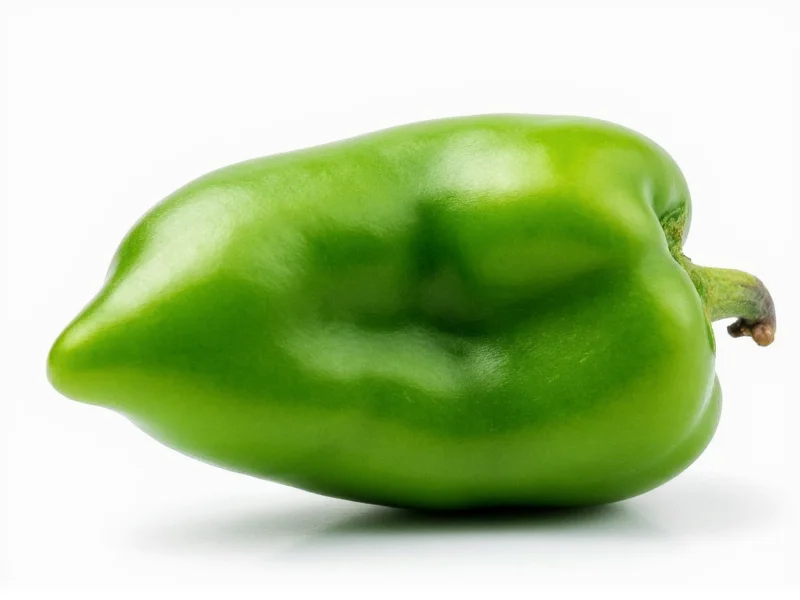Understanding poblano pepper heat levels helps home cooks and chili enthusiasts make informed decisions in the kitchen. These versatile peppers, native to Mexico and central America, offer a distinctive earthy flavor with just a hint of warmth that enhances dishes without overwhelming them.
What the Scoville Scale Reveals About Poblano Peppers
The Scoville scale measures capsaicin concentration—the compound responsible for chili heat. Poblanos sit comfortably in the lower range at 1,000-2,000 SHU, making them accessible to most palates. For context, this means you'd need to eat approximately 8-10 poblanos to match the heat of a single average jalapeño (2,500-8,000 SHU).
Unlike many chilies, poblanos rarely deliver unexpected heat spikes. Their consistent mildness makes them ideal for stuffed pepper recipes, mole sauces, and roasted vegetable medleys where flavor takes precedence over fire.
Factors That Influence Poblano Heat Levels
Several elements affect poblano pepper spiciness:
- Growing conditions: Stressors like inconsistent watering or extreme temperatures can increase capsaicin production
- Ripeness: Green poblanos (common in US markets) tend to be milder than their red-ripened counterparts
- Individual variation: Like all chilies, heat can vary between plants even within the same crop
- Preparation method: Removing seeds and white membranes reduces heat significantly
Poblano Pepper Heat Compared to Common Varieties
| Pepper Variety | Scoville Heat Units | Heat Comparison |
|---|---|---|
| Bell Pepper | 0 SHU | 0x (No heat) |
| Poblano Pepper | 1,000-2,000 SHU | 1x (Baseline) |
| Pepperoncini | 100-500 SHU | 0.25x milder |
| Jalapeño Pepper | 2,500-8,000 SHU | 4-8x hotter |
| Serrano Pepper | 10,000-23,000 SHU | 10-20x hotter |
| Habanero Pepper | 100,000-350,000 SHU | 100-175x hotter |
Culinary Applications of Mild Heat Peppers
Chefs value poblano peppers for their complex flavor profile that combines mild heat with rich, almost chocolatey notes. When roasted, they develop a smoky sweetness that complements both vegetarian and meat-based dishes.
For authentic Mexican cuisine, poblano peppers shine in traditional recipes like:
- Chiles en nogada (stuffed poblanos with walnut sauce)
- Mole poblano (the namesake sauce containing chocolate and spices)
- Rajas con crema (sliced roasted poblanos in cream sauce)
Home cooks often substitute poblanos for bell peppers when seeking subtle warmth without sacrificing texture. Their thick walls hold up well to stuffing, grilling, and baking—unlike thinner-walled hot peppers that might disintegrate during cooking.
Handling Tips for Poblano Pepper Preparation
While poblanos rank among the mildest chilies, proper handling ensures optimal results:
- Wear gloves when seeding if you have sensitive skin, though this is less critical than with hotter varieties
- Roast over open flame or under broiler for 3-5 minutes per side to loosen skin
- Steam in a covered bowl for 10 minutes after roasting to facilitate peeling
- Remove all white pith and seeds if preparing for heat-sensitive diners
- Freeze roasted poblanos for year-round access to authentic flavor
Understanding poblano pepper scoville measurements helps you anticipate their behavior in recipes. Unlike unpredictable chilies, poblanos deliver consistent mild heat that enhances rather than dominates dishes. Their versatility explains why they've become staples in both traditional Mexican cooking and contemporary fusion cuisine.
Common Questions About Poblano Pepper Heat
How does poblano pepper heat compare to other common cooking peppers?
Poblanos (1,000-2,000 SHU) are milder than jalapeños (4-8x hotter) and serranos (10-20x hotter), but slightly hotter than pepperoncinis. They offer noticeable warmth without overwhelming heat, making them ideal for dishes where flavor matters more than fire.
Can poblano peppers ever be as hot as jalapeños?
While extremely rare, stressed poblano plants might produce peppers approaching 5,000 SHU—still below average jalapeño heat. Most poblanos remain consistently mild, with heat levels rarely exceeding 2,500 SHU even under suboptimal growing conditions.
Why do some recipes call for roasted poblano peppers instead of fresh?
Roasting transforms poblano peppers by developing complex smoky-sweet flavors while reducing perceived heat. The charring process breaks down some capsaicin compounds, making roasted poblanos milder than their raw counterparts while enhancing their earthy, almost chocolate-like notes essential in traditional Mexican sauces.
Do poblano peppers get hotter as they ripen from green to red?
Yes, red-ripened poblanos typically measure 20-30% hotter than their green counterparts while developing sweeter, fruitier notes. The extended time on the plant allows for greater capsaicin development, though even red poblanos remain firmly in the mild-to-medium heat category compared to other chili varieties.











 浙公网安备
33010002000092号
浙公网安备
33010002000092号 浙B2-20120091-4
浙B2-20120091-4